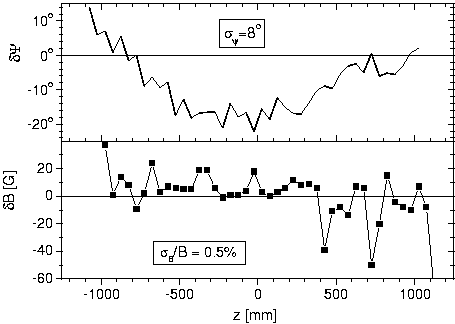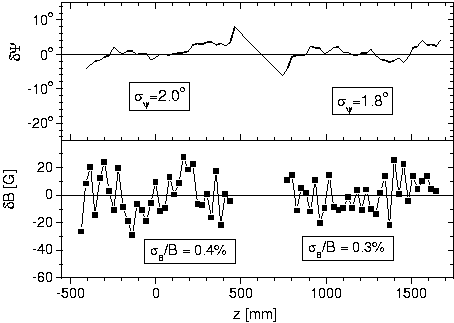|
Two undulators (U27 and U50) are intended to be installed at the beam of ELBE to produce intense coherent radiation in the mid and far infrared range. To estimate the quality of the undulator we have measured the field strength B along the undulator axis z. In particular we consider the standard deviations sB and sY of the magnetic field amplitude B and of the optical phase Y from their values in case of an ideal magnet. In an undulator with period length lU and rms parameter Krms, the optical phase is given by [1]
where z(t) is the electron coordinate along the undulator axis and x¢ º dx/dz = e/(gmc)òzdz¢ By(z¢) is the angle the electron makes with the z-axis in the transverse magnetic field By (m, -e and g denote mass, charge and energy of the electron; l is the resonance wavelength l = (1+K2rms) lU/2g2). In an ideal planar undulator, the phase (1) oscillates uniformly with half the undulator period around a constant value if the resonance condition is fulfilled. For a realistic undulator, strength and period of the field scatter around the values in case of ideal field.

Fig. 1 Deviations dY,dB of phase (1) and field amplitudes from their values in case of perfectly sinusoidal magnetic field as measured for the U50 undulator at the gap g=20 mm. sY,B denotes the variance of the corresponding quantity. 
Fig. 2 The same as in Fig. 1 for the two units of the U27 undulator at the gap g=14 mm. Similar results have been obtained for other gaps.
Apart from the drift length between the two undulator units, where the electron does not interact
with the field, the phase deviation for U27 (Fig. 2) is significantly smaller
than for U50 (Fig. 1).
That is the result of the meticulous tuning procedure applied to the U27 undulator.
For the ELBE beam (sE » 90 keV) the first term in eq. (2) amounts to roughly 0.5% at E=40 MeV so that sB/B » 0.5% is only just small enough not further to reduce the laser gain considerably. On the other hand, the investigations of Bobbs et al. [2] have shown that a phase deviation smaller than 10o does not significantly affect the laser gain.
References
|
